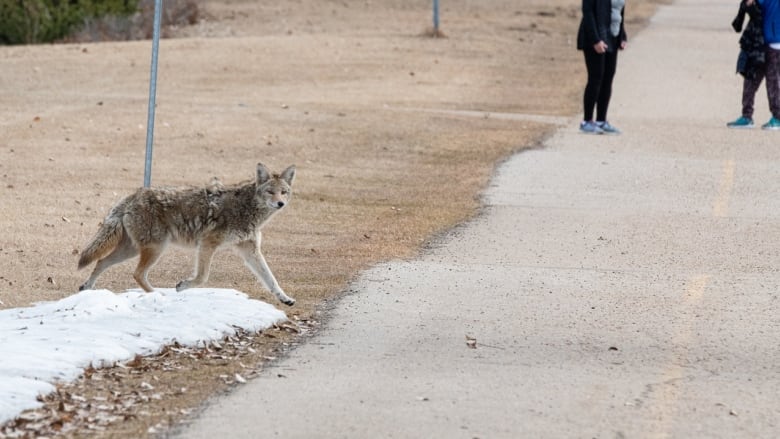Nationwide tracking sought for rare disease that is spread by canines, fatal if untreated
Alberta particularly hit by new cases of disease spread by coyotes, dogs and foxes

As cases creep upward of a rare disease that spreads to humans from wild canines and dogs, medical experts say it's important to get a better understanding of its incidence across the country.
Alveolar echinococcosis (AE) is an infection caused by the parasite Echinococcus multilocularis, which is carried by coyotes, dogs and foxes. The tapeworm common in Europe was first detected in wildlife in Western Canada in 2012; one year later, the first human case of AE was found in a woman in rural Alberta.
Since then, 30 more people in Alberta alone have received the same diagnosis, including more than a dozen cases since 2020.
"There have been cases diagnosed across the country now but to my knowledge, not as many as in Alberta and particularly in northern Alberta," said Dr. Dave Waldner, an infectious diseases doctor at the University of Alberta who cares for patients with the condition.
According to infectious diseases surveillance reports, there have been four cases reported in Ontario since 2017. Cases have also been identified in Saskatchewan and B.C.
Waldner said experts are planning to meet later this month to discuss starting a nationwide registry to develop a better understanding of the disease across Canada.
"We'll hopefully know more in the coming months," he said.
How humans get it
Dave Rajotte, who has a livestock farm in Peebles, Sask., was diagnosed with AE last year after going to the hospital with stomach pain. At the time, he thought he was having problems with his gallbladder.
It turned out he had a large tumour in his liver.
Rajotte does not know how he contracted the disease, but he has a hunch it came from a dog he'd spent a lot of time with that had a large tumour on its abdomen.

Waldner said it's not easy to determine how people were infected but the majority of his patients have been dog owners. About two-thirds of his patients have been individuals who live in rural areas, the rest have been found among people in the Edmonton area.
Animals pass infectious eggs in their stool, which humans can inadvertently ingest.
In the vast majority of cases, Waldner said, the infection goes to the liver and forms a mass. The process is so slow that most people have no symptoms; the mass is only discovered after they've undergone scans for other reasons.
In about a third of his cases, patients have sought care because they were dealing with larger masses causing pain or blockages, Waldner said.

How is it treated?
There's an urgency in getting a diagnosis as soon as possible, Waldner said. Surgery is the only way to completely remove the mass but it can't be attempted if the mass becomes too large or invasive.
Left untreated, the disease can be fatal but medical therapies can control the infection, he said.
Rajotte takes an anti-worm medication called Albendazole twice a day and has scans every three to six months to monitor the condition.

His wife, who is a nurse, helps him change a device every few days that collects fluid from his chest. Because of the device, Rajotte can't go swimming or enjoy water sports, but otherwise his daily life has not changed much.
"I feel way better today than I did last September when I got out of the hospital," he said.
But he worries about the tumour spreading, whether the condition will continue to be controlled or if he might require a liver transplant in the future.
How are coyotes getting it?
Scott Sugden, now a PhD student in natural resource sciences at McGill University, studied coyotes and E. multilocularis as a research assistant at the University of Alberta.
Sugden said researchers knew from previous studies that urban coyotes were more likely to be infected with the parasite than rural ones and that more than half of Edmonton's coyote population is infected with the parasite.
They wanted to know why that might be.
Using 112 coyote carcasses collected between 2017 and 2020, the researchers examined their stomach contents, looking for clues about the their short and long-term diets. Their findings were published last month in the peer-reviewed journal PLOS ONE.

Sugden and his co-authors found that age was the strongest driver of infection in the coyote population, meaning younger animals were more likely than older ones to carry the parasite.
Sugden said that wasn't surprising since younger animals have less-developed immune systems.
With regards to diet, the researchers wondered if the large amount of rodent habitat in Edmonton's river valley might mean urban coyotes could have more exposure to the parasite. They also thought the urban coyotes would be more susceptible to infection by eating poor-quality food, as well as rodents that were also attracted to that food.
"We actually found evidence that both of our hypotheses were true — that, especially in younger coyotes, eating rodents makes you more likely to be infected and eating compost or garbage makes you more likely to be infected," said Sugden.
Not only is compost and garbage unhealthy for coyotes, but it also attracts the parasite-carrying rodents, like voles and mice, which coyotes happily eat.
Preventing the spread
AE doesn't spread between people and the risk of getting it is low.
According to information from Alberta's Chief Medical Officer of Health, routine handwashing, washing wild-picked foods before eating them, keeping pets clean, and preventing them from eating rodents are some of the best prevention strategies.
Waldner recommends dog owners talk to their veterinarians about routine deworming and Sugden suggests securing compost and garbage so coyotes can't find it.

